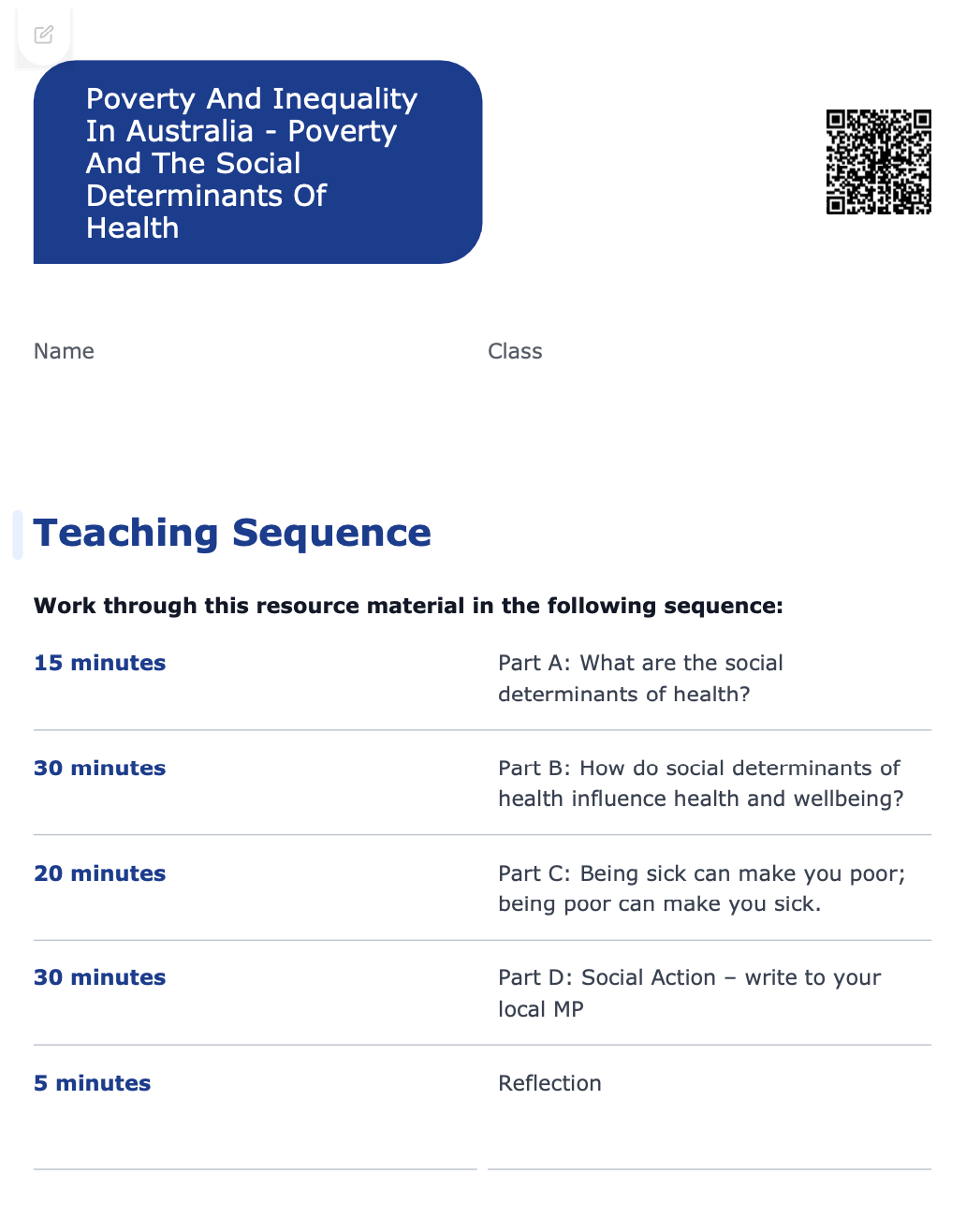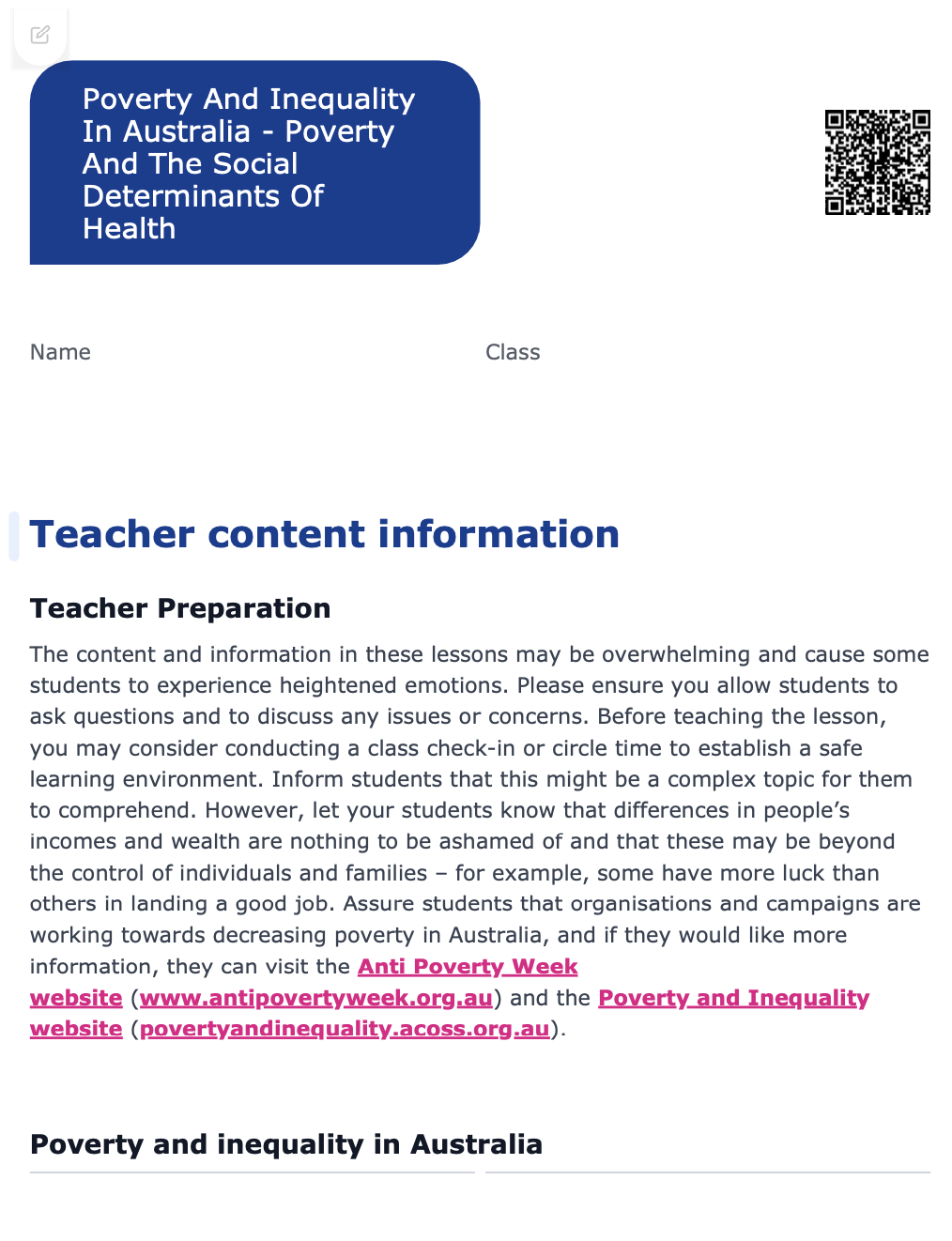Lesson summary
What is the link between health and poverty? In this lesson, students explore the underlying non-medical factors, known as the social determinants of health, and how they influence health outcomes. Utilising statistical information, the class explores the interconnected nature of poverty, health, and social determinants while identifying some of the main drivers of poverty. Students comprehend how factors such as improved social security payments, employment opportunities, and affordable housing can reduce poverty and improve health outcomes. The lesson culminates in a social action task where students use their voices to advocate for better government policies for those experiencing poverty.
Learning intentions:
Students understand...
- when people are experiencing poverty, their health may be affected
- how the social determinants of health are influenced by poverty
- how to propose ways to support others who face financial hardship.
Success criteria:
Students can...
- identify the negative impact that poverty has on health and well-being
- explain the role that the social determinants have on health
- determine the effect that increased social welfare and affordable housing will have on health
- formulate a compelling piece of writing advocating for those experiencing poverty.
Lesson guides and printables
Curriculum links
Select your curriculum from the options below.
Lesson details
Skills
This lesson is designed to build students’ competencies in the following skills:
- communication
- community engagement
- critical thinking
- empathy
- ethical understanding
- initiative
- problem solving
- social skills
Curriculum Mapping
Australian Curriculum content descriptions:
Years 7 & 8 HPE:
- Evaluate health information and communicate their own and others’ health concerns (ACPPS076)
- Plan and use health practices, behaviours and resources to enhance health, safety and wellbeing of their communities (ACPPS077)
Syllabus outcomes: PD4-1, PD4-2, PD4-7
General capabilities: Literacy, Information and Communication Technology (ICT) Capability, Critical and Creative Thinking, Personal and Social Capabilities, Ethical Understanding
Cross-curriculum priority: Sustainability
Relevant parts of Year 7 & 8 achievement standards:
By the end of Year 8, students evaluate the impact on wellbeing of relationships and valuing diversity. They analyse factors that influence emotional responses. They investigate strategies and practices that enhance their own, others’ and community health, safety and wellbeing. They examine the cultural and historical significance of physical activities and examine how connecting to the environment can enhance health and wellbeing.
Students apply personal and social skills to establish and maintain respectful relationships and promote safety, fair play and inclusivity. They demonstrate skills to make informed decisions and propose and implement actions that promote their own and others’ health, safety and well-being.
UN Sustainable Development Goals
UN SDG 1: End poverty in all its forms everywhere
- Target: 1.1: By 2030, eradicate extreme poverty for all people everywhere, currently measured as people living on less than $1.25 a day.
- Target: 1.1: By 2030, ensure that all men and women, in particular the poor and the vulnerable, have equal rights to economic resources, as well as access to basic services, ownership and control over land and other forms of property, inheritance, natural resources, appropriate new technology and financial services, including microfinance.
Resources Required
- A device capable of presenting a video to the class
- A device that allows students to conduct research in a safe manner
- Student Worksheets – one copy per student
Additional nfo
Time required: 100 mins
Level of teacher scaffolding: Medium – facilitate class discussion, lead students in activities
These lessons have been designed in consultation with Anti-Poverty Week and ACOSS/UNSW Poverty and Inequality Partnership.
The content and information in these lessons may be overwhelming and cause some students to experience heightened emotions.
Please ensure you allow students to ask questions and to discuss any issues or concerns. Before teaching the lesson, you may consider conducting a class check-in or circle time to establish a safe learning environment. Inform students that this might be a complex topic for them to comprehend. However, let your students know that differences in people’s incomes and wealth are nothing to be ashamed of and that these may be beyond the control of individuals and families – for example, some have more luck than others in landing a good job.
Assure students that organisations and campaigns are working towards decreasing poverty in Australia, and if they would like more information, they can visit the Anti Poverty Week website and the Poverty and Inequality website.




Welcome back!
Don't have an account yet?
Log in with:
Create your free Cool.org account.
Many of our resources are free, with an option to upgrade to Cool+ for premium content.
Already have an account?
Sign up with:
By signing up you accept Cool.org's Terms and Conditions(Opens in new tab) and Privacy Policy(Opens in new tab).